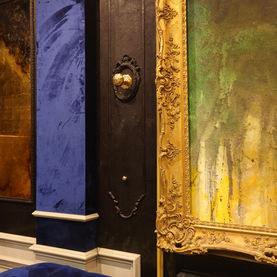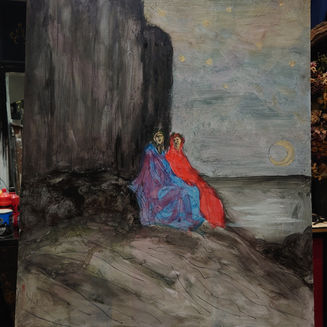

In The Studio
Scroll down for more " Work in Progress " projects :
- The Divine Comedy and more The Blue Boy -
The following set of pictures were taken in the London studio during the making of some of the series found on the other pages.
We thought it would be a pleasant idea to share with you the atmosphere of this amazing place and the creative vibration that has become a signature of the studio.
Gallery
Click below
Work in Progress
The Divine Comedy
The following first series consists of 12 pieces, four of each book of The Divine Comedy by Dante Alighieri and illustrated by Gustave Dore.
This collection is an interpretation of the two giant’s work, both, text and the illustrations, in a contemporary visual approach, heavy textures and contrasts will be characteristic of the completed work, using both conventional and non-conventional materials.
The Divine Comedy is an epic poem written in three parts by Dante Alighieri in the 14th century and it tells the story of the soul’s journey in the afterlife. It is a tremendous and breath-taking body of work both in literature and visual expression.
The full story is divided in three parts: The Inferno, Purgatory and Paradiso and it has Dante himself as a mortal protagonist in the afterlife being guided through all circles and levels, from the lowest to the highest. It is a story of human spiritual ascension.
Gustave Dore is a French artist and illustrator from the 19th century who illustrated The Divine Comedy in approximately 140 plates. His outstanding work is still echoing through time just as much as Dante’s work.
The following pictures are of paintings still a work in progress, all paintings are mix-media on canvas, 120cm x 100cm.
All pictures are taken in the artist’s studio in London, UK.
Gallery
Click below
Work in Progress
The Blue Boy
Hieronymus Bosch and The Blue Boy
Hieronymus Bosch (c.1450 – 9 August 1516) was a Dutch/Netherlandish painter from Brabant. He is one of the most notable representatives of the Early Netherlandish painting school. His work, generally oil on oak wood, mainly contains fantastic illustrations of religious concepts and narratives. Within his lifetime his work was collected in the Netherlands, Austria, and Spain, and widely copied, especially his macabre and nightmarish depictions of hell. His most acclaimed works consist of a few triptych altarpieces, including The Garden of Earthly Delights.
Triptych of the Temptation of St. Anthony is one of the most famous Bosch's works along with The Garden of Earthly Delight. It shows Saint Anthony being tempted in the desert by demons, whose temptations he resisted; the Temptation of St Anthony (or Trial...) is the more common name of the subject.
Little is known of Bosch's life, though there are some records. Today, Bosch is seen as a highly individualistic painter with deep insight into humanity's desires and deepest fears. Attribution has been especially difficult; today only about 25 paintings are confidently given to his hand along with eight drawings. About another half-dozen paintings are confidently attributed to his workshop.
His most acclaimed works consist of a few triptych altarpieces, including The Garden of Earthly Delights.

Banksy and The Blue Boy
Banksy is a pseudonymous England-based street artist, political activist and film director whose real name and identity remain unconfirmed and the subject of speculation.
Active since the 1990s, his satirical street art and subversive epigrams combine dark humour with graffiti executed in a distinctive stencil technique. His works of political and social commentary have appeared on streets, walls and bridges throughout the world. Banksy's work grew out of the Bristol underground scene, which involved collaborations between artists and musicians.

Francis Bacon and The Blue Boy
Francis Bacon (28 October 1909 – 28 April 1992) was an Irish-born British figurative painter known for his raw, unsettling imagery. Focusing on the human form, his subjects included crucifixions, portraits of popes, self-portraits, and portraits of close friends, with abstracted figures sometimes isolated in geometrical structures.
Bacon's series of Popes, largely quoting Velázquez's famous portrait of Pope Innocent X (1650, Rome) are striking images which further develop motifs already found in his earlier works, like the Study for Three Figures at the Base of a Crucifixion, such as the screaming open mouth. The figures of the popes, pictorially isolated by partly curved parallel lines indicating psychological forces and symbolising inner energy like strength of feeling, are alienated from their original representation and, stripped of their representation of power to allegories of suffering humanity.

Francisco Goya and The Blue Boy
Francisco Goya (30 March 1746 – 16 April 1828) was a Spanish romantic painter and printmaker.
He is considered the most important Spanish artist of the late 18th and early 19th centuries. His paintings, drawings, and engravings reflected contemporary historical upheavals and influenced important 19th- and 20th-century painters. Goya is often referred to as the last of the Old Masters and the first of the moderns.
Records of Goya's later life are relatively scant, and ever politically aware, he suppressed a number of his works from this period, working instead in private. He was tormented by a dread of old age and fear of madness. Goya had been a successful and royally placed artist, but withdrew from public life during his final years.
































